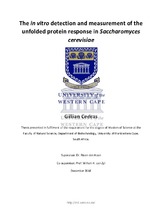| dc.contributor.advisor | den Haan, Riaan | |
| dc.contributor.advisor | van Zyl, Willem H. | |
| dc.contributor.author | Cedras, Gillian | |
| dc.date.accessioned | 2019-05-09T07:28:05Z | |
| dc.date.available | 2019-05-09T07:28:05Z | |
| dc.date.issued | 2018 | |
| dc.identifier.uri | http://hdl.handle.net/11394/6743 | |
| dc.description | >Magister Scientiae - MSc | en_US |
| dc.description.abstract | Bioethanol is currently the most widely used biofuel and can be used as a direct replacement for current fossil fuel based transportation fuels. Consolidated bioprocessing (CBP), in which bioethanol is produced in a single reactor by a single microorganism, is a cost-effective way of producing bioethanol in a second generation process using lignocellulosic biomass as feedstock. The yeast Saccharomyces cerevisiae possesses industrially desirable traits for ethanol production and is able to produce heterologous cellulases, which are required for CBP. However, S. cerevisiae produces low titres of cellulases and one suspected reason for this is the stress caused by the heterologous proteins that induce the unfolded protein response (UPR). The UPR is a stress response pathway that will either lead to increased folding capacity within the ER or to degradation of these proteins and possibly apoptosis of the cell. It is thus beneficial to be able to determine when and to what extent the UPR is active during CBP organism development. Current methods of measuring the UPR include RNA and reverse transcriptase qPCR (r.t.qPCR) measurements, which can be cumbersome and expensive. The purpose of this study was to develop a vector based biosensor that will detect and quantify UPR activation. The vector consisted of either the T.r.xyn2 or eGFP reporter genes under the control of the S. cerevisiae HAC1p or KAR2p promoters. HAC1 and KAR2 are important regulators of UPR as their activation allows the UPR to achieve its function. The eGFP reporter under the transcriptional control of KAR2p was shown to be the superior combination due to the improved dynamic range when the UPR was induced in transformed S. cerevisiae strains by the stress inducer, tunicamycin. This UPR biosensor also proved to be more sensitive when measuring UPR induction in cellulase producing strains, depicting significant differences, compared to previous r.t.qPCR based tests which were unable to detect these differences. We thus developed a UPR biosensor that has greater sensitivity for changes in UPR induction compared to RNA based methods and the first KAR2p based UPR biosensor plasmid that allowed for more accurate detection and measurement of the UPR in cellulase secreting S. cerevisiae strains. The ability to quantify UPR induction will assist in identifying candidate cellulase genes that do not greatly induce the UPR, making them ideal to use in developing CBP yeasts. | en_US |
| dc.language.iso | en | en_US |
| dc.publisher | University of the Western Cape | en_US |
| dc.subject | Cellulases | en_US |
| dc.subject | Saccharomyces cerevisiae | en_US |
| dc.subject | CBP yeast | en_US |
| dc.subject | Unfolded protein response | en_US |
| dc.subject | In vitro | en_US |
| dc.title | The in vitro detection and measurement of the unfolded protein response in Saccharomyces cerevisiae | en_US |
| dc.rights.holder | University of the Western Cape | en_US |

